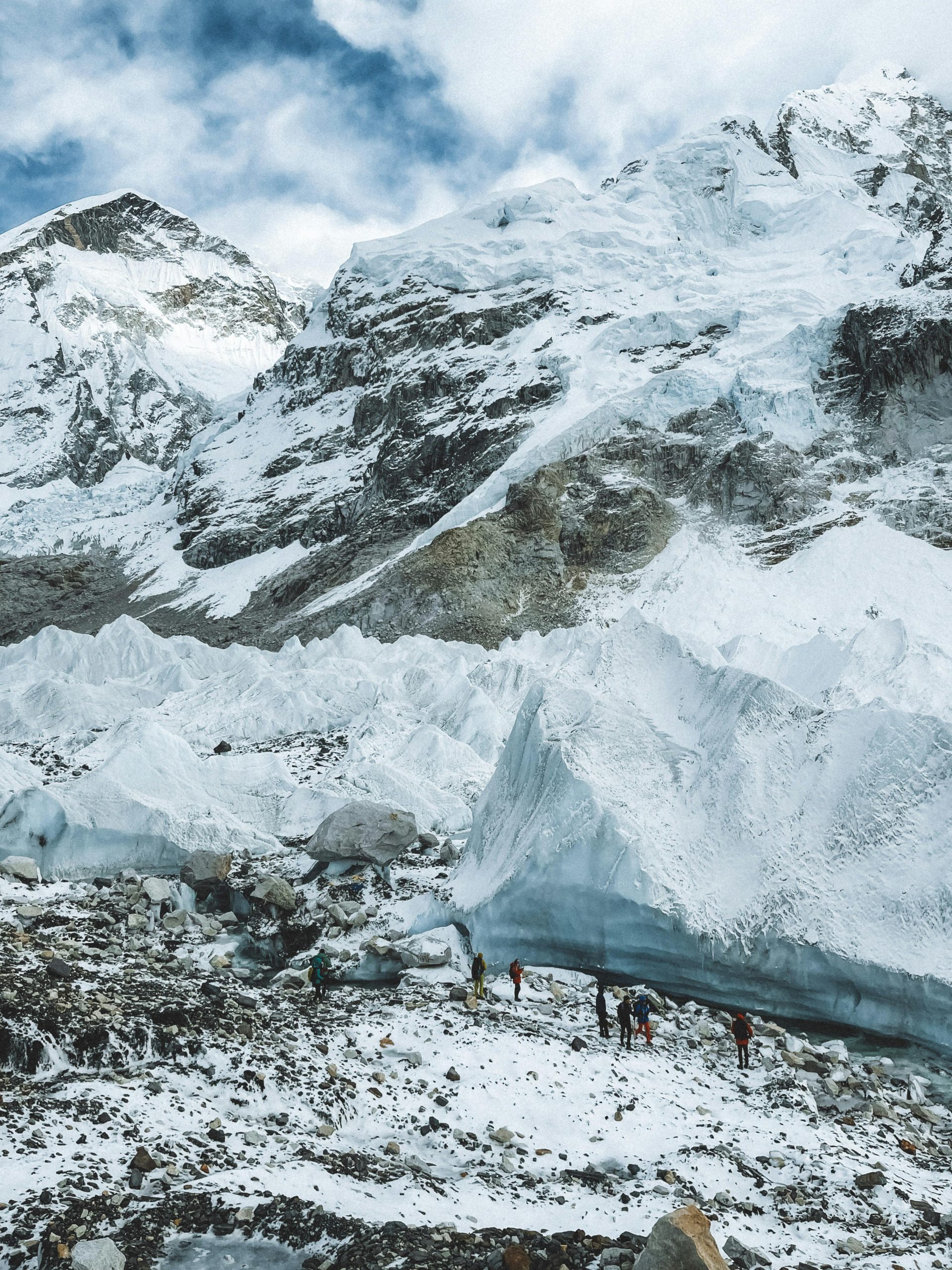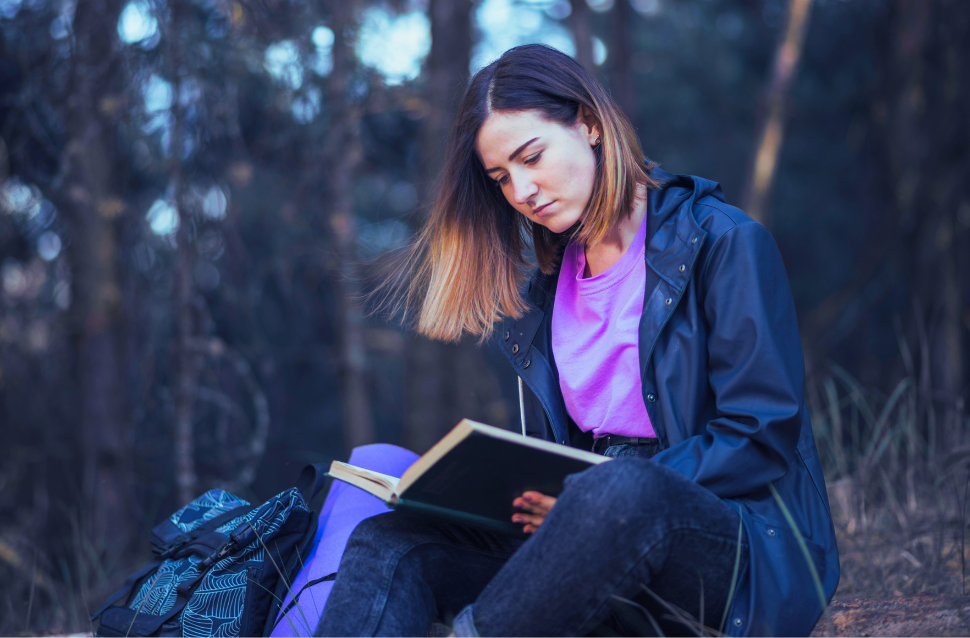Everest Base Camp Yoga Trek offers an unparalleled adventure that harmonizes the profound serenity of yoga with the breathtaking grandeur of trekking to Everest Base Camp. This journey begins each day with invigorating meditation, pranayama, and asana practice, setting a tranquil and reflective tone for your hike. As you traverse the rugged and awe-inspiring trails towards the world’s highest peak, you will detach from modern distractions and align with the natural rhythms of the Himalayas. This exquisite fusion of physical challenge and spiritual enrichment fosters a deep connection with your inner self and the majestic landscape, leading to a unique sense of tranquility and personal growth.
“In the serene practice of yoga and the boundless expanse of nature, we discover the profound space to reconnect with our true selves.”
An Overview of the Everest Base Camp Yoga Trek Experience
The Everest Base Camp Yoga Trek offers a unique adventure that blends hiking with yoga. As you make your way to Everest Base Camp, you’ll experience breathtaking views of the Himalayas and start each day with refreshing yoga sessions. These morning practices, which include stretching and relaxation exercises, help prepare your body for the hike ahead. This combination of physical activity and mindful practice keeps you fit, calm, and deeply connected to the stunning natural surroundings. It’s an adventure that challenges you physically while providing moments of peace and self-discovery.
Why the Everest Base Camp Yoga Trek is Unique for you?
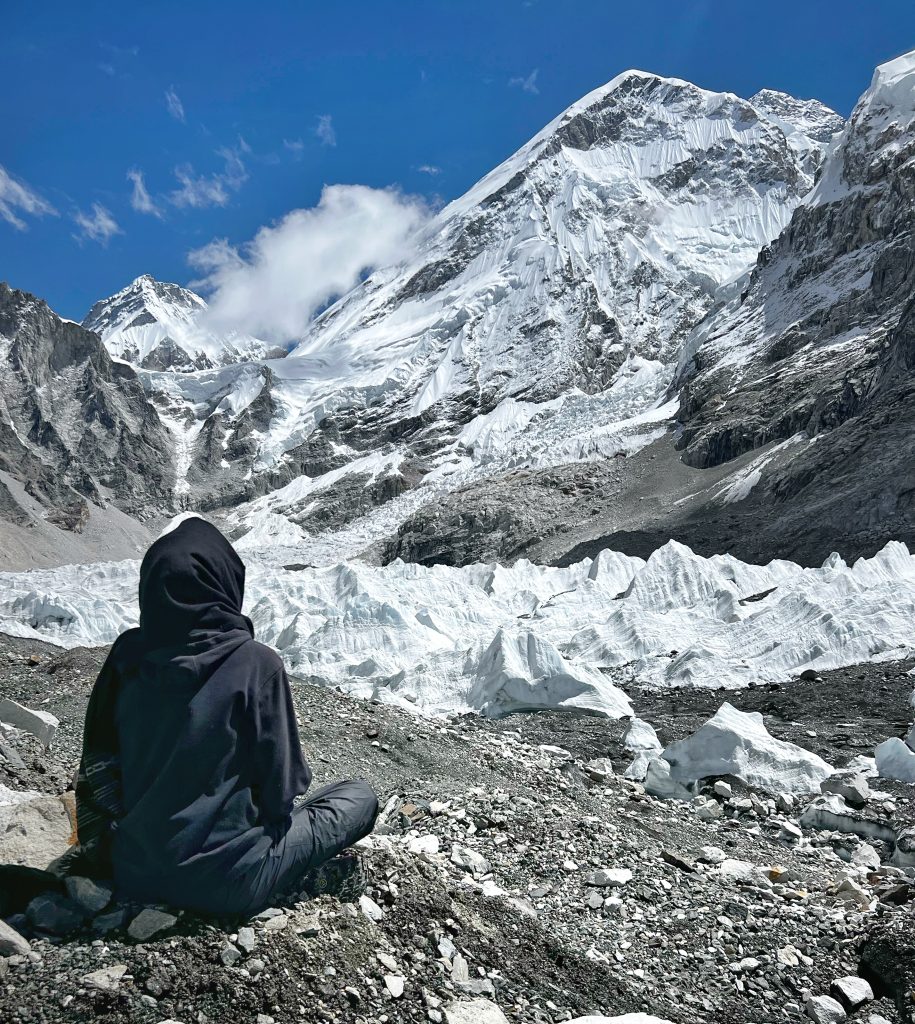
This trek stands out because it merges the physical challenge of hiking with the calming practice of yoga. Each day begins with yoga practices like meditation, breathing exercises, and stretches, which help you feel centered and ready for the trek. Hiking through rugged trails, you’ll be treated to incredible Himalayan views that enhance the yoga experience, helping you escape everyday stresses and connect with nature. This journey not only tests your limits but also offers a unique opportunity for personal growth and inner peace.
The Spiritual Aspect
Yoga is more than just exercise; it’s a path to inner peace. On this trek, yoga helps you explore and connect with your inner self. Morning meditation enhances mindfulness, breathing exercises boost your energy, and stretches keep you flexible for the hike. The tranquil Himalayan environment amplifies the spiritual benefits of yoga, providing a serene backdrop for deep reflection and a stronger connection to yourself and nature.
How hard is the Everest Base Camp Yoga Trek?
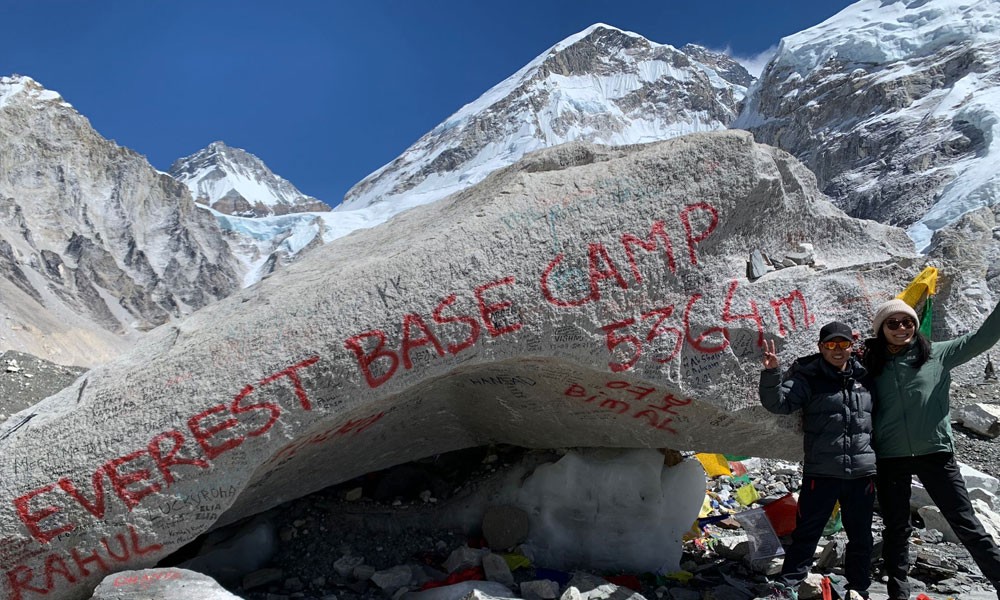
The Everest Base Camp Yoga Trek is an adventurous and physically demanding journey that also offers a spiritual and enriching experience. Here’s a closer look:
High Altitude: The trek reaches Everest Base Camp at 5,364 meters (17,598 feet). At this height, the air has less oxygen, which can make breathing difficult and increase the risk of altitude sickness. To help your body adjust, you’ll need to take it slow and allow extra days for acclimatization.
Difficult Terrain: The route includes steep uphill sections, rocky paths, and uneven trails. This terrain requires good physical endurance and can be tiring, as some days involve hiking for 4 to 8 hours. The climb from Phakding to Namche Bazaar is particularly strenuous due to its steep gradient.
Harsh Weather: The weather can be very cold, especially at higher altitudes, with temperatures often dropping below freezing. Conditions can also be unpredictable, with the potential for snow, strong winds, and sudden changes in weather, making it essential to have proper gear.
Length of the Trek: The journey typically spans 12 to 14 days, demanding sustained energy and stamina. Daily hikes are long and physically taxing, requiring you to maintain your strength and fitness throughout the trek.
Remote Location: The trek takes you through remote areas with limited access to medical facilities. Any health issues need to be managed carefully, and it’s important to be prepared for emergencies.
Cultural and Environmental Respect: Adhering to local customs and environmental practices adds an extra layer of responsibility. You’ll need to dress modestly, respect local traditions, and follow Leave No Trace principles to protect the pristine environment.
Mental Strength: The combination of physical exertion, high altitude, challenging weather, and the trek’s length requires mental resilience. Staying motivated and focused, even when facing difficulties, is crucial to completing the journey.
Itinerary For Everest Base Camp Yoga
Here is the 14-day Everest Base Camp Yoga Trek itinerary that we will follow during our yoga and trekking adventure.
Day 1: Arrival in Kathmandu
- Arrival: When you arrive at Kathmandu Airport, situated at 1,400 meters (4,600 feet), you can book a cab using the Pathao or Indrive apps available on the Play Store. Alternatively, you can find many cabs outside the airport, including some that operate offline. If you are booked with a trek office like Manasukh, they will also pick you up from the airport and take you to your destination.
- Evening: After resting, you’ll have a schedule discussion in the evening. If you’re interested in yoga sessions to help relieve any anxiety from your flight, these can be included if you are booking with an office that offers both yoga and trekking services like Manasukh
Day 2: Fly to Lukla and Trek to Phakding

- Morning:
- Flight to Lukla: Your journey starts with an exciting 30-40 minute flight from Kathmandu to Lukla, which is situated at 2,860 meters (9,383 feet). As you fly, the breathtaking aerial views of the snow-capped Himalayas and lush valleys will showcase nature’s beauty, offering a fantastic panorama as you approach Lukla’s dramatic landscape.
- Trek to Phakding: Upon landing in Lukla, you’ll begin a 3-4 hour trek to Phakding, situated at 2,610 meters (8,563 feet). The trail gently descends through lush forests and terraced fields, following the Dudh Koshi River. Along the way, you’ll enjoy the peaceful scenery of traditional Sherpa villages and vibrant green landscapes.
- Afternoon:
- Lunch: After your 3-4 hour trek, it’s time for lunch. You can enjoy a hearty meal at a cozy local tea house, as arranged by your trek office, or choose your own spot if you’re trekking independently.
- Arrival in Phakding: After lunch or a short break, continue your trek to Phakding, taking in the beauty of nature and the charming villages along the way. You’ll reach Phakding by sunset, where you can enjoy the serene views of the surrounding hills and the peaceful atmosphere of the river valley.
- Evening:
- Yoga Session: After reaching Phakding and settling into your tea house or lodge—booked either individually(if you are alone) or through your travel agency(going trek through the travel agency)—take some time to rest. Then, participate in an evening yoga session designed to soothe your muscles and rejuvenate you for the next day’s trek. The session may include practices like sound healing and more.
- Dinner: Following the yoga session, enjoy a typical and healthy Nepali meal at the tea house or lodge where you’re staying.
- Rest: After dinner, you can relax and enjoy the evening in the tea house or hotel, either with the group or on your own. If you prefer, you can also rest quietly in Phakding.
Day 3: Trek to Namche Bazaar
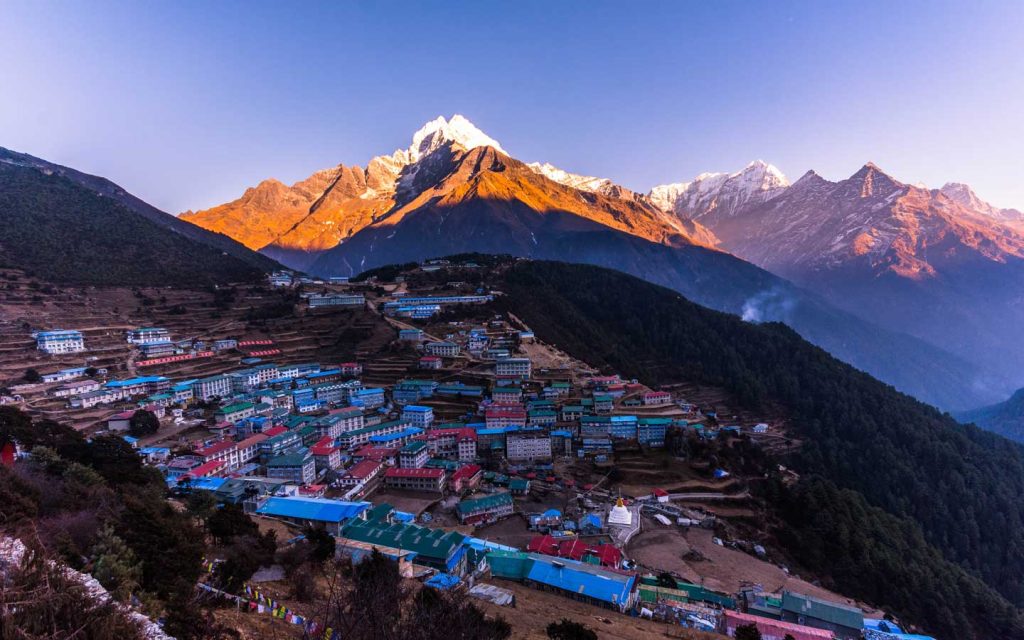
- Morning:
- Breakfast: Enjoy breakfast at your lodge.
- Trek to Namche Bazaar: Trek for about 6-7 hours from Phakding to Namche Bazaar, located at 3,440 meters (11,286 feet). The trail includes a challenging ascent through dense forests and across multiple suspension bridges over the Dudh Koshi River. Marvel at the stunning views of the Himalayas and the dramatic landscape of the Khumbu region.
- Afternoon:
- Lunch: Stop at a tea house for lunch with scenic views.
- Arrival in Namche Bazaar: Arrive in Namche Bazaar, the largest town in the Everest region, known for its vibrant markets and panoramic views of the surrounding peaks.
- Evening:
- Explore: Visit local markets and shops.
- Yoga Session: Join an evening yoga session to help with altitude acclimatization.
- Dinner: Enjoy traditional Nepali cuisine.
- Rest: Overnight in Namche Bazaar.
Day 4: Acclimatization Day in Namche Bazaar
- Morning:
- Breakfast: Start with breakfast at your lodge.
- Day Hike: Take a day hike to the Everest View Hotel at 3,880 meters (12,730 feet), which takes about 2-3 hours. This hike offers panoramic views of Mount Everest and other towering peaks. Alternatively, hike to Khumjung Village, which provides a glimpse into traditional Sherpa life and offers a 4-5 hour round trip with stunning views.
- Afternoon:
- Lunch: Enjoy lunch with spectacular views at the Everest View Hotel or in Khumjung.
- Explore: Spend the afternoon relaxing or exploring Namche Bazaar.
- Evening:
- Yoga Session: Join an evening yoga session to aid in acclimatization.
- Dinner: Dine at your lodge or a local restaurant.
- Rest: Overnight in Namche Bazaar.
Day 5: Trek to Tengboche
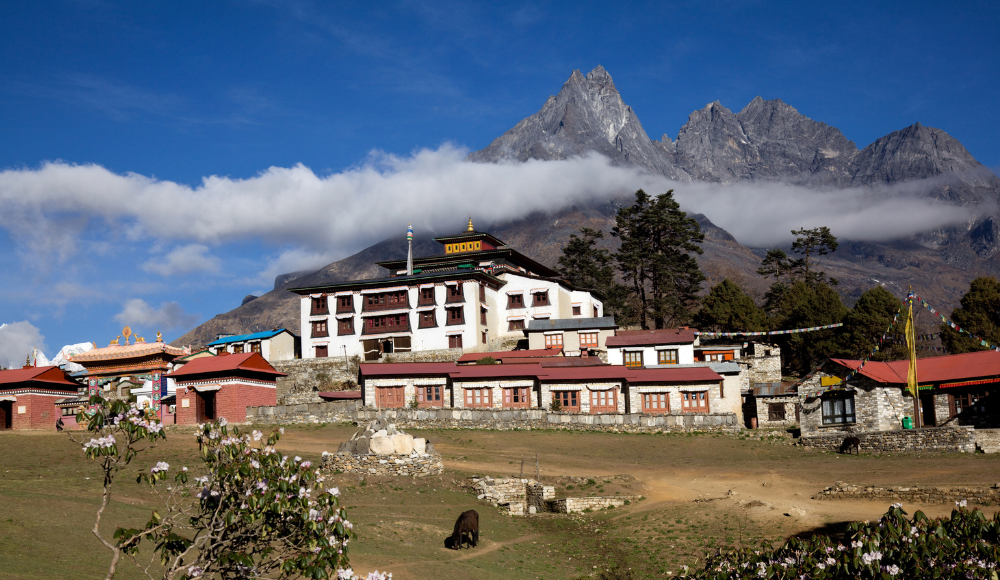
- Morning:
- Breakfast: Have breakfast at your lodge.
- Trek to Tengboche: Trek for about 5-6 hours from Namche Bazaar to Tengboche, located at 3,860 meters (12,660 feet). The trail offers magnificent views of Everest, Ama Dablam, and other peaks, as well as beautiful forests.
- Afternoon:
- Lunch: Stop for lunch at a tea house along the trail.
- Arrival in Tengboche: Explore Tengboche and its monastery, renowned for its breathtaking views and spiritual significance.
- Evening:
- Monastery Visit: Visit Tengboche Monastery and, if available, attend a prayer ceremony.
- Yoga Session: Relax with an evening yoga session.
- Dinner: Enjoy dinner at your lodge.
- Rest: Overnight in Tengboche.
Day 6: Trek to Dingboche
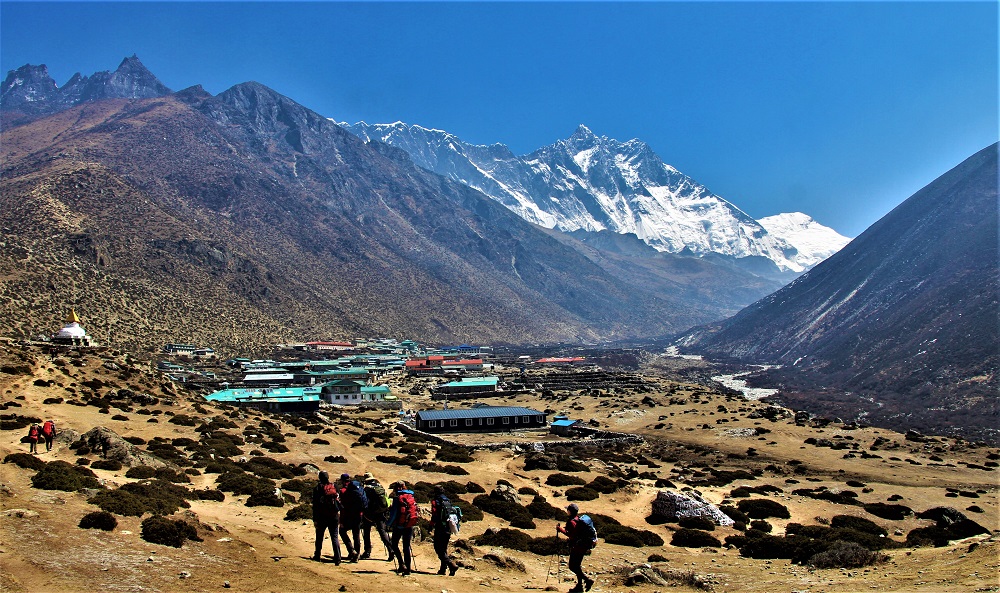
- Morning:
- Breakfast: Enjoy breakfast at your lodge.
- Trek to Dingboche: Trek for about 5-6 hours from Tengboche to Dingboche, situated at 4,410 meters (14,470 feet). The landscape becomes more arid and rugged, with dramatic views of high Himalayan peaks and glaciers.
- Afternoon:
- Lunch: Enjoy lunch at a tea house on the trail.
- Arrival in Dingboche: Arrive in Dingboche, surrounded by snow-capped peaks and glaciers, offering a serene high-altitude setting.
- Evening:
- Yoga Session: Join an evening yoga session to aid acclimatization.
- Dinner: Dine at your lodge.
- Rest: Overnight in Dingboche.
Day 7: Acclimatization Day in Dingboche
- Morning:
- Breakfast: Enjoy breakfast at your lodge.
- Day Hike: Take a hike to Chhukung Valley or a higher viewpoint. This hike takes about 3-4 hours and helps with acclimatization while offering spectacular views of surrounding peaks and glaciers.
- Afternoon:
- Lunch: Have lunch in Chhukung or return to Dingboche.
- Explore: Relax or explore Dingboche, taking in the high-altitude beauty.
- Evening:
- Yoga Session: Join an evening yoga session.
- Dinner: Dine at your lodge.
- Rest: Overnight in Dingboche.
Day 8: Trek to Lobuche
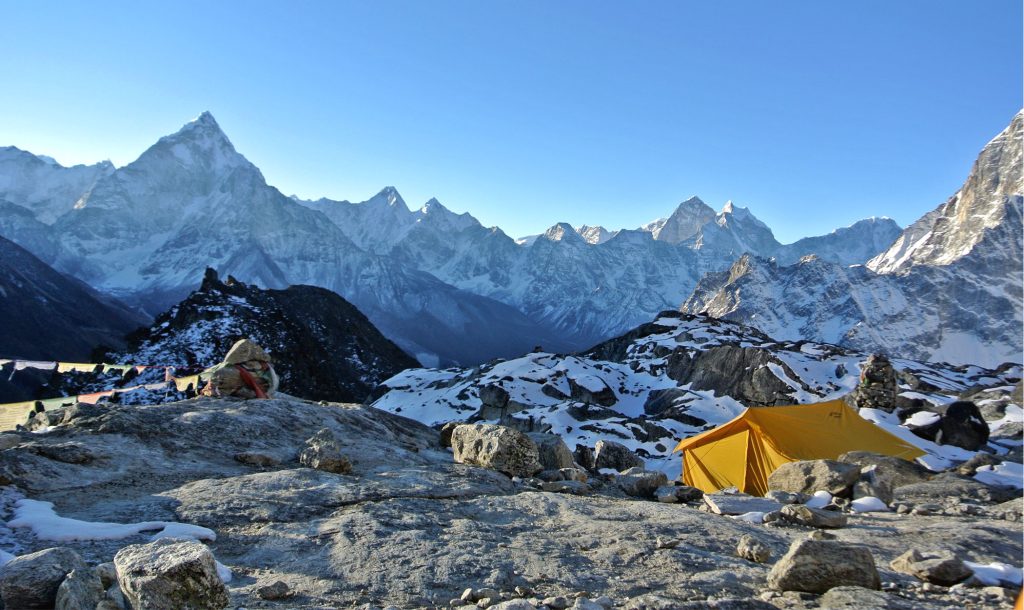
- Morning:
- Breakfast: Have breakfast at your lodge.
- Trek to Lobuche: Trek for about 5-6 hours from Dingboche to Lobuche, located at 4,940 meters (16,207 feet). The terrain becomes more barren and rocky, with breathtaking glacier views.
- Afternoon:
- Lunch: Stop for lunch at a tea house along the trail.
- Arrival in Lobuche: Arrive in Lobuche and enjoy panoramic views of the surrounding peaks and glaciers.
- Evening:
- Yoga Session: Participate in an evening yoga session to prepare for high-altitude trekking.
- Dinner: Enjoy dinner at your lodge.
- Rest: Overnight in Lobuche.
Day 9: Trek to Everest Base Camp and Return to Gorak Shep
- Morning:
- Early Breakfast: Have an early breakfast at your lodge.
- Trek to Everest Base Camp: Trek for about 7-8 hours from Lobuche to Everest Base Camp at 5,364 meters (17,598 feet). The rocky and challenging trail rewards you with spectacular views of the Khumbu Icefall and Everest.
- Afternoon:
- Base Camp Arrival: Reach Everest Base Camp and take in the awe-inspiring views. Enjoy a packed lunch at Base Camp.
- Return to Gorak Shep: Trek back to Gorak Shep, spending approximately 3-4 hours on the return journey.
- Evening:
- Yoga Session: Relax with an evening yoga session.
- Dinner: Have dinner at your lodge in Gorak Shep.
- Rest: Overnight in Gorak Shep.
Day 10: Trek to Pheriche
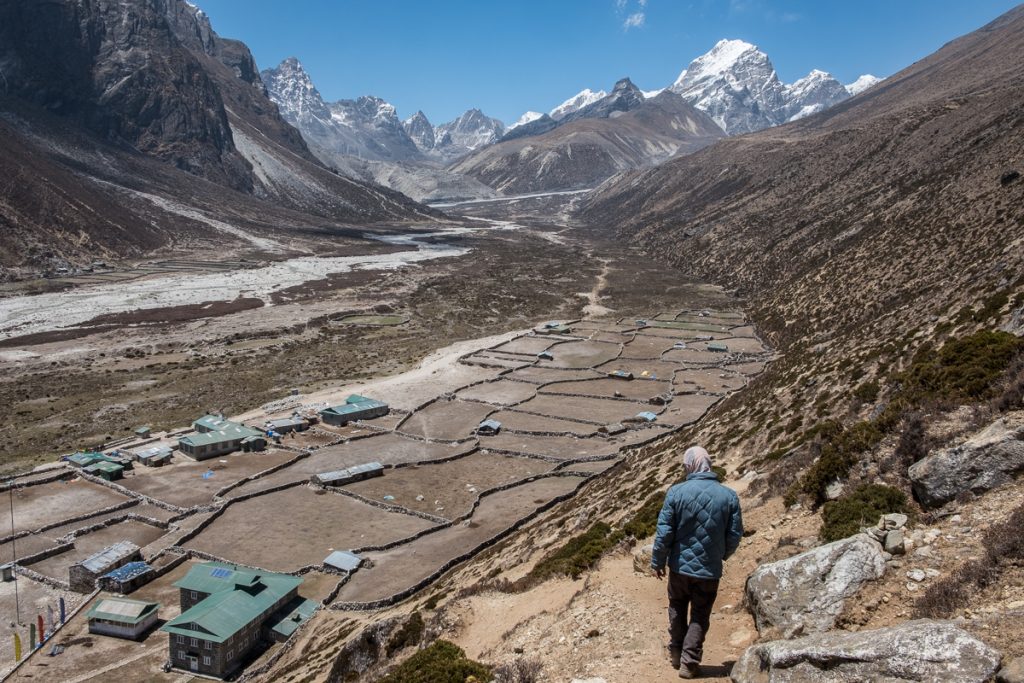
- Morning:
- Breakfast: Enjoy breakfast at your lodge.
- Trek to Pheriche: Trek for about 4-5 hours from Gorak Shep to Pheriche, located at 4,240 meters (13,910 feet). The descent offers a different perspective of the landscape, transitioning from high-altitude barrenness to more gentle terrain.
- Afternoon:
- Lunch: Stop for lunch at a tea house along the way.
- Arrival in Pheriche: Arrive in Pheriche and settle into your lodge.
- Evening:
- Yoga Session: Participate in an evening yoga session to aid acclimatization.
- Dinner: Enjoy a meal at your lodge.
- Rest: Overnight in Pheriche.
Day 11: Trek to Namche Bazaar
- Morning:
- Breakfast: Have breakfast at your lodge.
- Trek to Namche Bazaar: Trek for about 5-6 hours from Pheriche to Namche Bazaar, retracing your steps through lush forests and picturesque Sherpa villages.
- Afternoon:
- Lunch: Stop for lunch at a tea house along the way.
- Arrival in Namche Bazaar: Arrive in Namche Bazaar and enjoy some free time to relax and explore.
- Evening:
- Yoga Session: Join an evening yoga session to unwind.
- Dinner: Dine at your lodge or a local restaurant.
- Rest: Overnight in Namche Bazaar.
Day 12: Trek to Lukla
- Morning:
- Breakfast: Have breakfast at your lodge.
- Trek to Lukla: Trek for about 6-7 hours from Namche Bazaar to Lukla, retracing your steps through the lush forests and scenic landscapes.
- Afternoon:
- Lunch: Stop for lunch at a tea house along the trail.
- Arrival in Lukla: Celebrate the completion of your trek with your team in Lukla.
- Evening:
- Yoga Session: Relax with an evening yoga session.
- Dinner: Enjoy a celebratory meal at a local lodge or restaurant.
- Rest: Overnight in Lukla.
Day 13: Fly Back to Kathmandu
- Morning:
- Early Flight: Take an early flight from Lukla back to Kathmandu, enjoying the stunning aerial views of the Himalayas one last time.
- Arrival: Check into your hotel in Kathmandu.
- Afternoon:
- Lunch: Have lunch at a luxury hotel in Kathmandu.
- Free Time: Spend the afternoon exploring Kathmandu’s attractions, shopping, or relaxing.
- Evening:
- Farewell Dinner: Enjoy a farewell dinner at a renowned restaurant, reflecting on your trekking adventure.
- Rest: Overnight in Kathmandu.
Day 14: Departure
- Morning:
- Breakfast: Enjoy breakfast at your hotel.
- Transfer to Airport: Transfer to the airport for your departure flight, bidding farewell to Kathmandu and the unforgettable memories of your Everest Base Camp Yoga Trek.
Fitness Requirements for the Everest Base Camp Yoga Trek

For the Everest Base Camp Yoga Trek, you need to be in good physical shape to handle the demands of high-altitude hiking and daily yoga. Here’s a clear and simple breakdown:
Fitness Level required:
- Good Overall Fitness: You should be generally fit, with the ability to walk long distances and handle strenuous activity. If you regularly exercise, especially with cardio activities like walking, running, or hiking, you’ll be well-prepared.
- Endurance: Be ready for long days of trekking. Each day involves hiking for several hours, sometimes up steep or uneven terrain. Building stamina through regular, long walks or hikes will help.
- Strength and Flexibility: Strong legs and core muscles are important for trekking up hills and managing rough terrain. Yoga practice can help with strength, flexibility, and balance, which will support you throughout the trek.
- Acclimatization Preparation: Hiking at high altitudes means less oxygen, which can make physical exertion harder. It’s useful to have experience with high-altitude treks, but if not, you can prepare by spending time at moderate elevations and doing aerobic exercises.
- Mental Stamina: The trek will be challenging, and having a positive attitude and mental resilience is key. Regular exercise can help build this mental toughness.
Training Tips
- Cardio Workouts: Engage in regular aerobic exercises like jogging, cycling, or hiking to build endurance.
- Strength Training: Focus on leg exercises (squats, lunges) and core workouts to prepare for uphill and downhill trekking.
- Hiking Practice: If possible, go on long hikes with a backpack to simulate trekking conditions.
- Yoga: Incorporate yoga into your routine to improve flexibility, balance, and stress management.
Best time for the Everest Base Camp Yoga Trek.
The best time to do the Everest Base Camp Yoga Trek is generally during the pre-monsoon and post-monsoon seasons. Here’s a more detailed breakdown:
Pre-Monsoon Season (Spring)
- Timing: Late March to May
- Advantages: This period offers stable weather, clear skies, and warmer temperatures. It’s a popular time for trekking because the views of Everest and other peaks are spectacular, and the trails are less crowded compared to the autumn season.
Post-Monsoon Season (Autumn)
- Timing: Late September to November
- Advantages: The weather is still relatively stable, and the temperatures are cooler but not excessively cold. The autumn season is less crowded than the spring, which can make for a more serene experience.
Avoiding Other Times:
- Monsoon Season (June to August): This period brings heavy rainfall, which can lead to landslides and difficult trekking conditions. The trails can be muddy and visibility can be poor.
- Winter Season (December to February): Winter can bring very cold temperatures, snow, and ice, making trekking challenging and potentially dangerous.
For the yoga component, both spring and autumn offer comfortable conditions for outdoor practice, with the added benefit of stunning mountain scenery.
How is Yoga included in the Trek ?
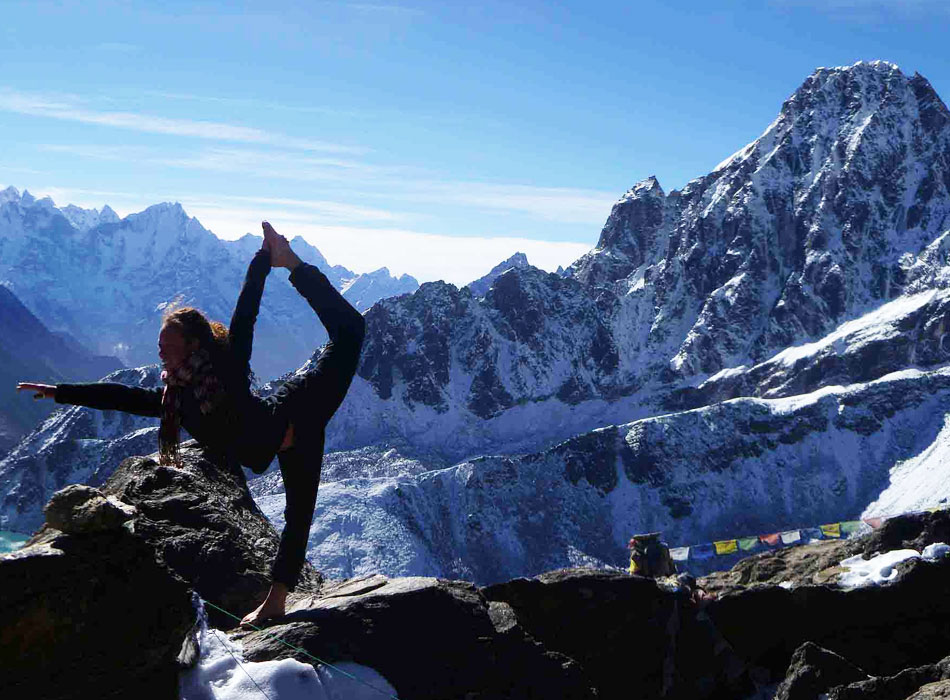
On the Everest Base Camp Yoga Trek, yoga is seamlessly integrated into your adventure to enhance both physical and mental well-being. Here’s how it’s incorporated throughout the trek:
1. Morning Yoga Sessions: Each day begins with a yoga practice, which typically includes a mix of stretching, breathing exercises, and meditation. These sessions are designed to wake up your body gently, improve flexibility, and focus your mind. This preparation helps you tackle the day’s hike with greater ease and reduces the risk of injuries.
2. Breathing Techniques: Yoga’s breathing exercises (pranayama) are especially beneficial at high altitudes where the air is thinner. These techniques help improve your lung capacity and oxygen intake, which is crucial for better acclimatization and stamina during the trek.
3. Evening Yoga Practices: After a day of trekking, you’ll participate in evening yoga sessions. These practices are focused on relaxation and recovery, helping to ease muscle tension and promote better sleep. They also provide a peaceful moment to reflect on the day’s experiences and connect with the serene Himalayan environment.
4. Integration with Trekking: The yoga sessions are timed to complement your hiking schedule. Morning practices energize you for the day’s trek, while evening sessions aid in recovery and relaxation. This balance helps you stay physically strong and mentally calm throughout the journey.
5. Mental and Spiritual Growth: Yoga is not just about physical exercise; it also supports mental clarity and emotional resilience. The combination of physical challenge and yoga helps you maintain a positive mindset, manage stress, and connect deeply with the natural beauty of the Himalayas. This holistic approach fosters personal growth and inner peace.
Yoga Sessions During the Trek
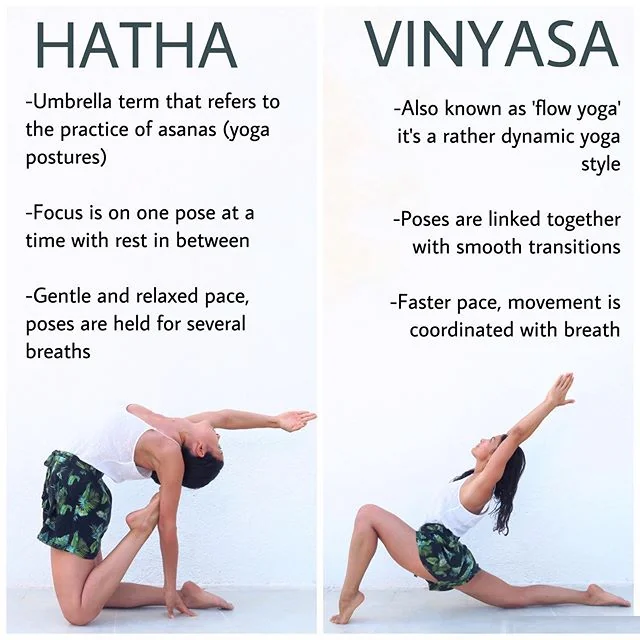
Throughout the Everest Base Camp Yoga Trek, yoga sessions are thoughtfully incorporated into your daily schedule to enhance physical endurance, mental clarity, and overall well-being. Yoga sessions during trek are designed to align with the hiking routine, providing both preparation and recovery. Here’s a detailed overview of how different types of yoga are practiced during the trek and their benefits:
1. Morning Yoga Sessions:
- Purpose: Each day begins with a morning yoga session that combines Hatha Yoga, Vinyasa Yoga, and Pranayama (breathing exercises).
- Benefits: This practice helps to gently awaken your body, increase flexibility, and focus your mind. Hatha Yoga and Vinyasa Yoga prepare you physically for the trek by improving flexibility and circulation, while Pranayama enhances lung capacity and oxygen intake, crucial for high-altitude acclimatization.
2. Breathing Techniques (Pranayama):
- Purpose: Breathing exercises are a key component of the morning and evening yoga sessions.
- Benefits: At high altitudes, where oxygen is limited, Pranayama helps improve lung capacity and oxygen absorption, aiding in acclimatization and maintaining stamina. These techniques also help manage altitude sickness and keep you energized throughout the trek.
3. Evening Yoga Sessions:
- Purpose: Evening yoga focuses on Restorative Yoga and gentle stretches.
- Benefits: These sessions help relax tired muscles, reduce tension, and promote recovery after a day of trekking. Evening yoga also aids in better sleep and provides a peaceful moment to reflect on the day’s experiences and connect with the serene Himalayan environment.
4. Mindfulness Meditation:
- Purpose: Included in both morning and evening practices, mindfulness meditation enhances mental clarity and emotional resilience.
- Benefits: This practice helps you stay calm and centered amidst the physical and emotional challenges of the trek. It fosters a deeper connection with the natural beauty of the Himalayas and supports personal growth and inner peace.
Integration with Trekking
Alignment with Hiking Schedule:
- Purpose: Yoga sessions are timed to complement the hiking routine.
- Benefits: Morning yoga energizes you for the trek, while evening sessions aid in recovery and relaxation. This balance helps maintain physical strength, mental focus, and overall well-being, making the trek more manageable and enjoyable.
Holistic Approach
Combining Yoga and Trekking:
- Purpose: The integration of various yoga practices supports physical endurance, mental clarity, and spiritual growth.
- Benefits: By incorporating Hatha Yoga, Vinyasa Yoga, Restorative Yoga, Pranayama, and mindfulness meditation, the trek offers a comprehensive approach to fitness and relaxation. This ensures a balanced and enriching experience, promoting personal growth and a deeper connection with the natural beauty of the Everest region.
Accommodation and lodges on the Everest Base Camp Yoga Trek
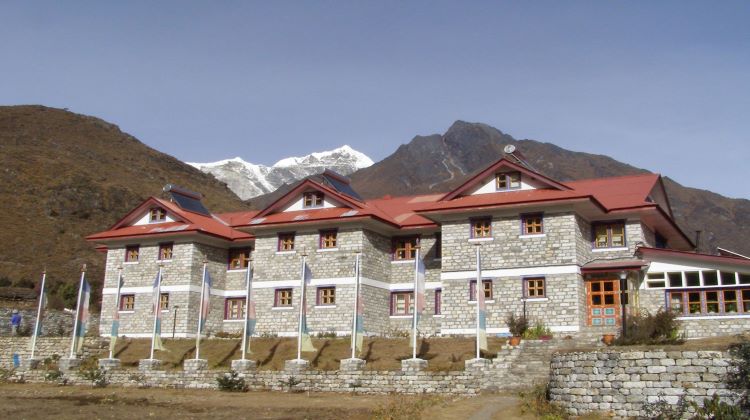
On the Everest Base Camp Yoga Trek, your stay will be in a variety of comfortable lodges and teahouses that add a unique charm to your journey. Each lodge offers a distinctive experience, blending comfort with breathtaking views of the Himalayas:
1. Hotel Everest View (Namche Bazaar)
- Description: Nestled high above Namche Bazaar, this lodge provides stunning panoramic views of Mount Everest and the surrounding peaks. Its high-altitude location combines luxury with unparalleled mountain vistas.
- Highlight: The terrace offers some of the best sunrise views of Everest, perfect for reflecting on your yoga practice and the day ahead.
2. Tengboche Monastery Guesthouse (Tengboche)
- Description: Located near the revered Tengboche Monastery, this guesthouse offers simple yet cozy accommodations. The surrounding serene environment is ideal for relaxation and spiritual reflection.
- Highlight: The guesthouse’s location allows for easy visits to the monastery, where you can witness traditional Buddhist ceremonies and enjoy stunning views of Everest and Ama Dablam.
3. Yeti Mountain Home (Pheriche)
- Description: This lodge provides a higher standard of comfort with well-furnished rooms and a warm ambiance. Known for its excellent food and hospitality, it’s a great spot to rest and acclimatize.
- Highlight: The lodge’s peaceful environment and impressive mountain views make it a perfect place to unwind after a day’s trek and prepare for the high-altitude challenges ahead.
4. Himalayan Lodge (Lukla)
- Description: Situated in Lukla, the starting point of your trek, this lodge offers a welcoming atmosphere with clean, comfortable rooms. It’s an excellent place to start your adventure.
- Highlight: The lodge’s location provides a chance to acclimate to the altitude before the trek and enjoy the bustling atmosphere of Lukla.
5. Lodge in Gorak Shep (Gorak Shep)
- Description: The lodges in Gorak Shep are basic but essential, offering a rustic charm amid the stark, high-altitude landscape. They provide necessary amenities close to Everest Base Camp.
- Highlight: Staying here puts you in proximity to Everest Base Camp, allowing you to visit the camp early in the morning and return to a warm meal and comfortable lodge.
Each accommodation on the trek offers a unique blend of comfort and natural beauty, making your journey to Everest Base Camp not only physically rewarding but also deeply enriching. The lodges provide a cozy retreat each night, complementing the spiritual and physical aspects of the trek with their welcoming atmosphere and stunning surroundings.
Essential Packing List and Gear Recommendations for Your Everest Base Camp Yoga Trek
For the Everest Base Camp Yoga Trek, packing the right gear is crucial for both comfort and performance. Here’s a concise guide to essential items and gear recommendations:
- Clothing:
- Base Layers: Moisture-wicking and thermal tops and bottoms.
- Mid Layers: Fleece or lightweight insulated jackets.
- Outer Layers: Waterproof and windproof jacket and pants.
- Accessories: Warm hat, gloves, and thermal socks.
- Footwear:
- Hiking Boots: Sturdy, waterproof boots with good ankle support.
- Camp Shoes: Lightweight, comfortable shoes for evenings.
- Yoga Gear:
- Travel Yoga Mat: Lightweight and compact mat for daily practice.
- Comfortable Clothing: Yoga pants and tops suitable for the trek.
- Gear and Equipment:
- Backpack: A comfortable, durable daypack for daily essentials.
- Sleeping Bag: Rated for cold temperatures (ideally -10°C/14°F).
- Trekking Poles: Adjustable poles for stability on uneven terrain.
- Personal Items:
- First Aid Kit: Basic supplies for minor injuries and altitude sickness.
- Water Bottle and Purification Tablets: For hydration and safety.
- Sunscreen and Lip Balm: High SPF for protection against sun exposure.
- Documents and Extras:
- Travel Documents: Passport, permits, and insurance details.
- Camera: For capturing breathtaking views and memories.
Selecting the right gear will ensure you’re well-prepared for the physical demands of the trek and can fully enjoy the fusion of yoga and adventure in the Himalayas.
Cultural and Environmental considerations on the Everest Base Camp Yoga Trek
Cultural Respect and Sensitivity
During the Everest Base Camp Yoga Trek, it’s important to respect the Sherpa people’s culture. This means being polite when you visit monasteries and local villages, and following their customs and traditions. Dress modestly, ask before taking photos, and listen to your guides about local etiquette. Being respectful will make your experience better and help you have positive interactions with the community.
Environmental Care
It’s crucial to protect the beauty of the Everest region. Follow the Leave No Trace principles by taking all your trash with you and reducing your impact on the environment. Stay on marked trails to avoid harming plants, and use eco-friendly products whenever you can. The Himalayas are a pristine place, and keeping them clean is important for future trekkers.
By respecting the local culture and taking care of the environment, you help preserve the natural beauty and cultural heritage of the area. This makes your trek more meaningful and ensures that others can enjoy the same amazing experience in the future.
Cost Breakdown for the Everest Base Camp Yoga Trek
Everest Base Camp Yoga Trek cost typically includes the following elements, based on similar treks:
- Package Price: Approximately $2,200 – $2,800 USD per person
- Round-trip airfare from Kathmandu to Lukla
- Accommodation in lodges and teahouses
- All meals (breakfast, lunch, and dinner) during the trek
- Professional guide and porters
- Yoga sessions led by certified instructors
- Permits and entry fees (Sagarmatha National Park permit, TIMS card)
- First aid kit and emergency oxygen
- Transportation to and from Kathmandu
- Additional Costs:
- International Flight to Kathmandu: Variable, depending on departure city
- Travel Insurance: Approximately $100 – $200 USD
- Visa for Nepal: Around $30 – $50 USD
- Personal Expenses: Souvenirs, snacks, and additional activities (e.g., Everest View Hotel visit)
- Tips: For guides and porters, typically $100 – $150 USD
- Optional Costs:
- Equipment Rental: Items like sleeping bags and trekking poles, if not owned
- Additional Excursions: Optional side trips or extra nights in Kathmandu
Make sure to check with your trekking provider for precise pricing and inclusions, as costs can vary based on the season, group size, and specific services offered.
Conclusion
The Everest Base Camp Yoga Trek is a unique adventure that seamlessly combines the physical challenge of trekking with the serenity of yoga. Each day starts with invigorating yoga sessions to prepare you for the hike, while evenings offer relaxation and reflection. As you trek through the breathtaking Himalayas, you’ll experience both physical endurance and spiritual growth.
With diverse accommodations and stunning mountain views, this trek provides comfort and a deeper connection to nature. Prepare physically and mentally for this holistic journey, and immerse yourself in the adventure of a lifetime. Join us for an unforgettable experience where adventure and inner peace meet at the foot of the world’s highest peak.

